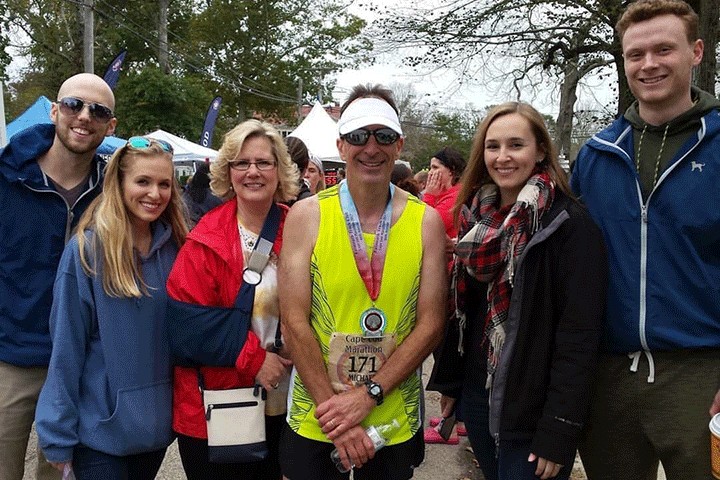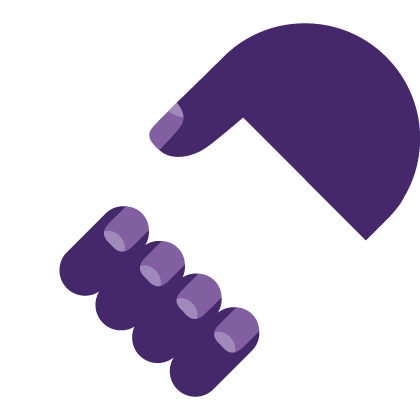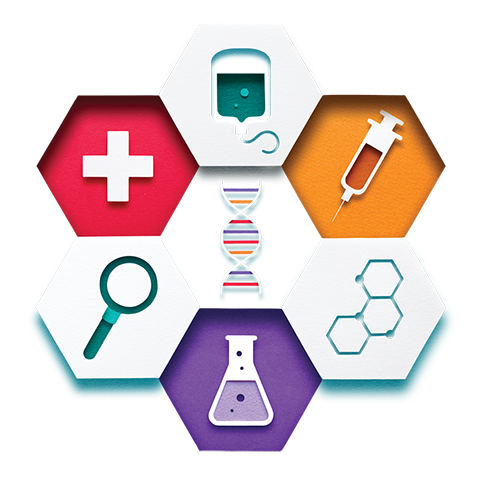Always Insist On More

- Diabetes and weight loss led to my diagnosis
- Blocked bile duct required a stent
- Chemo, then Whipple surgery
- Recurrence and more chemo
Looking back on my pancreatic cancer journey, a lot of the details are a blur. One thing that remains crystal clear is that my wife Wendy was by my side the entire time.
She is my partner, my advocate, and my rock. She also helped me keep track of all the nitty gritty details throughout the years. So it is with her help and excellent recollection that I am able to share my story.
I was diagnosed with type 2 diabetes in 2012. But in October 2014 I suddenly had trouble controlling my diabetes and I also began to lose weight…. A lot of weight. Within three months I had lost nearly 40 pounds. My stools had turned white and my urine was the color of dark tea. I had terrible “gut pains” and had to run to the bathroom at all hours. My doctor kept changing the pills I was on, but he never looked into my symptoms any further.
Insisting On More
As a longtime volunteer for the ambulance corps in rural Pine Island, New York, I had a glimpse of what these symptoms could mean. I did a lot of research and had a hunch that it was pancreatic cancer. At our insistence, my doctor finally referred me to an endocrinologist and gastroenterologist. I’m so glad that we asked for more. After completing a CT scan and a few other tests, they discovered a tumor on the head of my pancreas.
Treatment Delays
Before I could be treated for the cancer, however, my new doctors said my bile duct was blocked and I needed a stent inserted right away. I had the surgery but before my discharge from the hospital the next day (Saturday), my surgeon said he wasn’t sure the stent went in properly. He wanted me to call next week and come back for a check-up. When I got home it was clear something wasn’t right—my pain was increasing and Wendy noticed that I was getting more jaundiced by the hour.
A neighbor of ours, who happened to be a physician himself, urged us to reach out to Dr. John Chabot in the GI/Endocrine Surgery Department at Columbia University Irving Medical Center in New York City. The next morning Wendy faxed all of my paperwork to Columbia. The practice manager Shenelle Adams (whom Wendy and I lovingly refer to as our “angel”) brought my case to the doctor’s attention right away and he insisted that we get to the ER for an MRI as soon as possible…which we did! Thank goodness we didn’t wait until the next week.
It was a very cold night and the ER was overflowing with patients. Consequently, we sat there unseen for almost 24 hours, and I continued to feel worse and worse. I was ready to give up, but Wendy and our son Jim, who was on the phone with us from Memphis, Tennessee, insisted that I stay. Wendy asked to speak with the hospital’s patient advocate. That’s when the ER’s head nurse came over to us. Fifteen minutes later I was checked into the hospital and I received my MRI.
It turned out that the stent needed to be replaced immediately. By the next morning my skin was the color of yellow mustard. A spot on the surgery board miraculously opened up and I had my stent replaced that day. We could finally focus on the tumor in my pancreas.
Chemo First, Then a Whipple
Dr. Chabot said I was a good candidate for a Whipple procedure, but that I would start with a few rounds of chemo to shrink the tumor. Oncologist Dr. Yvonne Saenger (now at Montefiore Hospital in New York) quickly became our friend and trusted ally. I had a port put in my chest on January 16th, and began chemo with gemcitabine and Abraxane, plus drugs to manage the side effects, a week later. Our son and daughter came in from out of town that week for our daughter’s baby shower, and Wendy had to manage everyone’s schedules!
After another round of chemo I had a scan that showed the tumor was no longer on the main blood vessel. The tumor board agreed that I should have the Whipple surgery, with more chemo after.
On March 10 I had surgery. I was expecting to be in the hospital for at least two weeks, but I ended up going home after only three days! After recovering as much as I could, in April of 2015 I resumed chemotherapy for six additional months.
We had a lot of help from everyone at the hospital, from the people checking me in for chemo or tests to the people scheduling those tests, to the nurses and aides checking on me during treatments and tests. I managed to keep working during this time, even with my complicated schedule. Wendy kept a journal to track every test, appointment, and doctor.
Even with all this going on we had many great moments in between the treatments, like when we traveled to Tennessee in April to meet our new grandson.
Side Effects and Other Health Challenges
The Whipple procedure left me with some unexpected side effects. My insides had to relearn my body; I had terrible gas and bowel issues, and I became lactose intolerant. I was also given some drugs to counteract chemo side effects, which caused other problems. I had terrible bone pain from the Neulasta I was getting to keep up my white blood cells. A friend who had been treated for breast cancer recommended taking Claritin before my chemo. Dr. Saenger was ok with this, and it worked to reduce my bone pain!
On top of everything, in June I began to feel the side effects of the chemo—I had neuropathy, fluid retention that caused my ankles to swell, and rising blood pressure. Dr. Saenger sent me to Dr. Cheryl Kunis, a nephrologist, to monitor my kidney function. Despite these problems, in August Wendy and I went to our grandson’s christening in Tennessee.
I stopped having chemo in the autumn and had my port removed.
Bad News
In December we were planning another trip to Tennessee. A follow-up scan was scheduled for December 15th. Unfortunately, the scan showed the cancer had come back, although it was small and localized. We canceled our trip so that I could begin a different chemo regimen. At the end of December, the port was put back in, and a regimen of FOLFIRINOX was proposed. Dr. Saenger consulted with doctors at Memorial Sloan Kettering Cancer Center (New York), and everyone agreed that FOLFIRINOX was the right choice.
My treatment was still being managed at Columbia. Because FOLFIRINOX includes a pump that is worn for a few days after each treatment, I returned home with the pump attached to me and had it removed at the local hospital in Middletown, New York. This routine continued from January through July 2016. I did my best to keep working throughout the entire process. Sometimes I even made business calls while being hooked up to the chemo pump.
A Light at the End of the Tunnel
The chemo was working! My tumor markers were dropping and the scans showed that the tumors were shrinking. In August 2016 I had surgery on hernias caused by my Whipple incision. The surgeon looked everywhere and saw no signs of cancer. But the pain after that one was worse than the Whipple!
After chemo ended, I had scans every three months for a few years, and then every six months, and now just once a year. No matter what, you always get nervous with every scan. When scans had been good for a certain number of years we were told we could consider it remission. What a fabulous word to hear. I remain cancer-free to this day.
Notes from a Caregiver
Wendy’s journal was our lifeline and our bible. She had contact information for all of my doctors, pharmacies, insurance, and anyone else that was important. She documented all my test results along with my weight and anything else important. Wendy also had a list of every medication I was on. She kept a page of questions to ask the doctors at our upcoming visits. Being this organized (or having someone else that could be organized on my behalf) was a lifesaver.
Wendy also developed personal relationships with my caregivers at the hospital. She would bring them homemade cookies and treats during our visits. In her own way, it helped her move forward by caring for those that were caring for me.
One thing you do learn with cancer is Patience. You seem to always be in a waiting room, or waiting for results, or waiting for another appointment.
A New Normal
I am now 70 years old and I’m still here eight years after my diagnosis. Dr. Chabot is still my most trusted physician. I will have to take enzymes for the rest of my life. It took a long time to get the right dosage with every bit of food I put into my mouth. The medication is costly and I can’t go anywhere without it. This may seem like a difficult lifestyle, but it has become a normal part of my routine. I’ve had other health issues pop up over the years but basically we move forward each and every day and count our blessings.
I have lived to see many family milestones. Wendy and I have been married for 47 years, and I wasn’t sure I was going to make it past 39. In 2021 I saw my son get married. And I witnessed him retire last year from the Navy, after 23 years of serving our country, at a ceremony at Annapolis Naval Academy. He and his wife Melissa moved to Tennessee near our daughter’s family and are expecting late April of 2024.
As of December 31, 2023, I retired from my job as an Agricultural Sales Rep after 51 years. But I am still a volunteer fireman in our community, something I have done for 51 years.
I thank the staff at Columbia for getting me to this point so I could see all those milestones in our family. Just as important to me were the prayers from all over the country, from friends, family, my customers, our community, and our church. Those prayers helped me through.
I plan on sticking around a lot longer. There’s so much joy waiting to be had with Wendy, our kids, and our grandchildren. If this is the new normal, I’ll gladly take it. After all of this, my motto is “get on and live your life.”








